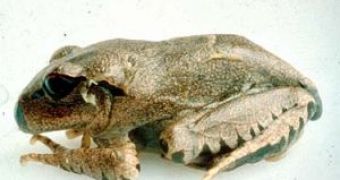This is the frog terminator: Batrachochytrium dendrobatidis, a fungus decimating complete populations of frogs and other amphibian species worldwide. The fungus kills off the frogs by clogging their skin and essentially asphyxiating them. By now it spread from Central America to Australia, Japan, Europe and the US. Researchers have been looking helplessly at this frog slayer how adding to habitat loss, climate change, contamination and exploitation of the species has lead to up to 120 frog species vanishing since 1980.
Now, a New Zealand team has found the much awaited cure for the infection: chloramphenicol, a human eye. Frogs bathed in this solution developed a type of resistance to the killer fungus. The research team was afraid that the deadly fungus could kill the New Zealand's critically endangered Archey's frog (Leiopelma archeyi), the world's most primitive living frog, having even a tail (!).
Chloramphenicol was administered to two species from New Zealand to Australia: the brown tree frog (Litoria ewingii) and the southern bell frog (L. raniformis). "We found that we could cure them completely of chytrids. And even when they were really sick in the control group, we managed to bring them back almost from the dead. You could put them on their back and they just wouldn't right themselves, they would just lie there. You could then treat them with chloramphenicol and they would come right," said Dr. Phil Bishop from the University of Otago.
Chloramphenicol was administered as both an ointment on the frogs' backs, and as a solution. The solution worked best. "You don't usually expect antibiotics to do anything to fungi at all. And it does. We don't understand why it does, but it does. It's also got the great advantage that it's incredibly cheap," said Professor Russell Poulter, a molecular biologist. "The disease has probably accounted for one-third of all the losses in amphibian species to date," said Professor Rick Speare, an expert in amphibian diseases who works with the University of Otago's frog research group. "We are losing an awful lot of these creatures now and if we don't do something intelligent, then we're going to lose an awful lot more," said Poulter.
What's even better is that the introduced frogs infected with Batrachochytrium develops immunity to future infections. "We haven't quite understood how that could happen. It might be a natural thing; if a frog survives a chytrid infection then it is resistant when it gets attacked again." said Bishop.
The new finding will allow the control of Batrachochytrium outbreaks or saving infected frogs from the wild. Now, the team just has to detect a treatment to be applied in the wild. "I would really feel quite satisfied if we could say, 10 years from now, that you have to be careful walking around [Australia's] Kosiuszko National Park or you might tread on a corroboree frog because they're all over the place. I would take real satisfaction from that.", said Poulter.

 14 DAY TRIAL //
14 DAY TRIAL //